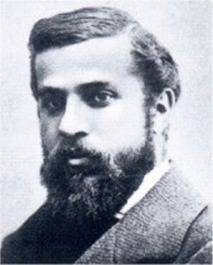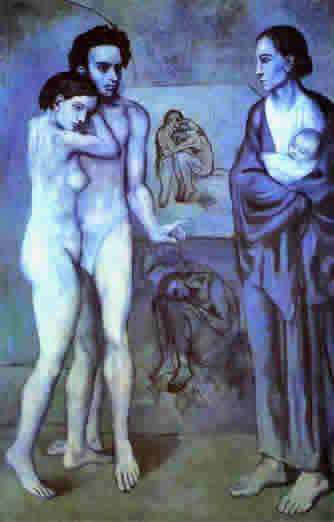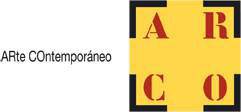
Antoni Gaudí
Idelfonso Cerdá’s plan for Barcelona (1861)

Pablo Picasso: “La vie”, 1903
Barcelona and Modernity: Gaudí to Dalí
Exhibition Dates: March 7 – June 3, 2007
Exhibition Location: The Tisch Galleries, second floor
Press Preview: Monday, March 5, 10:00 a.m.–noon
]]>
Barcelona and Modernity: Gaudí to Dalí — the first comprehensive exhibition of its type ever mounted in America — explores the diverse and innovative work of Barcelona’s artists, architects, and designers in the years between the Barcelona Universal Exposition of 1888 and the imposition of the Fascist regime of Francisco Franco in 1939. Barcelona and Modernity offers new insights into the art movements that advanced the city’s quest for modernity and confirmed it as the primary center of radical intellectual, political, and cultural activities in Spain. Pablo Picasso, Joan Miró, Salvador Dalí, and Antoni Gaudí are among the internationally renowned artists who contributed to the creative vitality of Barcelona and the flourishing of Catalan culture. On view at the Metropolitan Museum from March 7 through June 3, 2007, the exhibition will feature some 300 remarkable works in a range of media: painting, sculpture, drawings, prints, posters, decorative objects, furniture, architectural models, and design. La Vie and Blindman’s Meal, two of the greatest paintings from Picasso’s Blue Period; portraits by Ramon Casas; Isidre Nonell’s depictions of gypsies; Miró’s The Farm; Dalí’s surrealist paintings, as well as furniture designed by Gaudí and an original BKF (“butterfly”) chair are among the masterworks gathered from museums and private collections around the world for this major exhibition.
The exhibition is made possible by the Caixa Catalunya. Obra Social and the Generalitat de Catalunya.
Additional support is provided by Angelo, Gordon & Co.
The exhibition is also made possible in part by Jane and Robert Carroll and The Horace W. Goldsmith Foundation.
It was organized by The Cleveland Museum of Art and The Metropolitan Museum of Art, New York, in association with Museu Nacional d’Art de Catalunya, Barcelona. The exhibition opened at The Cleveland Museum of Art on October 15, and it will remain on view through January 7, 2007.
“During this incredibly fertile period, artists and designers in Barcelona — then the most sophisticated city in Spain — drew on new-found Catalan pride to engage in a rediscovery of local traditions coupled with the latest in avant-garde interests imported from France and Britain,” noted Gary Tinterow, Engelhard Curator in Charge of the Metropolitan Museum’s Department of Nineteenth-Century, Modern, and Contemporary Art. “The exhibition brings to life the growth of Barcelona, a century ago, into a cultural capital on the forefront of modern art.”
Barcelona and Modernity: Gaudí to Dalí presents Barcelona as a booming industrial city with conflicting politics and revolutionary works of art, architecture, and design. To explore the relationships among the visual arts, broader cultural activity, and political events of the era, the exhibition is organized in nine thematic sections, beginning with the origins of the Catalan Renaissance. The remaining sections focus on the major artistic movements that followed: Modernisme, Noucentisme, and other avant-garde idioms such as Surrealism, with a final section on works of art influenced by the Spanish Civil War.
Renaixença: The Catalan Renaissance (Section One)
The exhibition begins with an introduction to the revival of Catalan culture in the 19th century, when Barcelona expanded rapidly, becoming the largest, most industrialized, and most culturally advanced city in Spain. This set the stage for Barcelona’s transformation from a provincial city into one of the most dynamic center of modernist art and architecture in Europe. Following the destruction of the city’s medieval walls in 1856, the city expanded into an area known as the Eixample, home to most of the innovative Catalan modern architecture. In 1888, Barcelona celebrated its rising economic power and artistic growth by hosting a Universal Exposition of fine and industrial arts.
Highlights in this section of the exhibition include: Ildefons Cerdà’s (1815-1876) Plan for the Enlargement of Barcelona (1861); and Lluis Domènech i Montaner’s (1850-1923) iron sculpture Rooster Greeting the Dawn (1892), designed for the Café-Restaurant of the Universal Exposition.
Modernisme: Painting and Sculpture (Section Two)
Modern art in Barcelona originated with Modernisme, a broad Catalan cultural movement that emerged in the 1880s and lasted into the 1910s. During this period, progressive artists and intellectuals in Barcelona opened up to foreign influences and embraced radical new ideas and art forms, especially contemporary French art. Ramon Casas (1866-1932) and Santiago Rusiñol (1861-1931), the key founders of Modernista Catalan painting, turned to themes and subjects that reflected the new realities of modern urban life. They were followed by a second generation of Modernista artists led by Joaquim Mir (1873-1940), Isidre Nonell (1876-1911), and Pablo Picasso (1881-1973). Also featured are notable Modernista posters and graphic works by Alexandre de Riquer (1856-1929) and Adrià Gual (1872-1944).
Highlights include: Rusiñol’s painting Café de Montmartre (1890), Casas’ Portrait of Erik Satie (1891), and Josep Llimona’s (1864-1934) sculpture Grief (1907).
Modernisme: Els Quatre Gats (Section Three)
In 1897, Casas and Rusiñol joined with others to establish Els Quatre Gats (“The Four Cats”), a legendary café that became the focus of bohemian artistic activity in Barcelona and was the site of meetings, exhibitions, poetry readings and puppet theater performances. Picasso, at age 18, became a regular member of the group and held his first solo exhibition there in 1900.
Highlights include: Casas’ painting Ramon Casas and Pere Romeu on a Tandem (1897) and Picasso’s portraits of his fellow artists at the café (1899-1900).
Modernisme: Art and Society (Section Four)
At the turn of the 20th century, while the rapid industrialization of Barcelona created new fortunes and allowed for wide patronage of the city’s artists and designers, poor immigrants worked in harsh and unjust conditions, leading to social conflict, labor strikes and anarchist bombings. Although artists rarely made overtly political statements, they did look closely at both the wealthy bourgeoisie and the working poor. Paintings and drawings by Isidre Nonell and Picasso’s Blue Period depictions of beggars, prostitutes, and the disenfranchised reflect on the striking differences between Barcelona’s economic and social classes.
Highlights include: Ramon Casas’ The Garroting (1894), Nonell’s Two Gypsies (1903), and Picasso’s 1903 oil paintings La Vie (Life) and The Blindman’s Meal.
Modernisme: Architecture and Design (Section Five)
Modernisme also found expression in architecture, design and the decorative arts. Lluís Domènech i Montaner, Josep Puig i Cadafalch (1867-1957), Josep Jujol (1879-1949), Gaspar Homar (1870-1953), and Antoni Gaudí (1852-1926) designed Modernista buildings and interiors, which, while concurrent with Art Nouveau in northern Europe, were of considerable originality, often expressing aspirations towards a Catalan national style. A renewed interest in local traditions was responsible for remarkable works in wrought iron, stained glass, and ceramics. Among the masterpieces of the period are Domènech’s Palace of Catalan Music (1905-1908); Gaudí’s Casa Milà (1906-1910); and Gaudi’s iconic church, the Expiatory Temple of the Sagrada Família (begun 1883), which has since become a symbol for the city itself. These and other buildings are represented by drawings, models, and original fixtures and furnishings.
Highlights include: Puig i Cadafalch’s Ceiling Lamp from Casa Amatller (1898-1900) and Gaudí’s Dressing Table from Palau Güell (c. 1899) and Two-Seat Sofa from Casa Batlló (c. 1907).
Noucentisme: The New Classicism (Section Six)
During the 1910s and 1920s, art and design in Catalonia was characterized by a return to order known as Noucentisme or “Nineteen-hundreds Style.” Reacting against the perceived aesthetic excesses of Modernisme, Noucentista artists sought to revive the spirit of Catalonia’s classical past through forms and themes infused with the timeless values of Mediterranean civilization. Joaquím Torres-García (1874-1949), Joaquim Sunyer (1874-1956), and Feliu Elias (1878-1948) led the way in Noucentista painting. The movement also influenced decorative art and architecture, encouraging a revival of interest in traditional handcraftmanship, especially in ceramics, such as those by Josep Artigas (1892-1980). Works by Picasso and Salvador Dalí (1904-1989) are featured in this section as well.
Highlights include: Torres-García’s Project for the Fresco “The Eternal Catalonia” (1912) and Enric Casanovas’ (1882-1948) sculpture Persuasion (1912-1913).
Avant-Gardes for a New Century (Section Seven)
Barcelona’s Dalmau Gallery, established in 1912, was crucial in introducing avant-garde art to Catalonia. Beginning around 1916, international artists flocked to Barcelona and began to pursue inventive new art forms influenced by Cubism and Surrealism. Torres-García, Pablo Gargallo (1881-1934) and Joan Miró (1893-1983) were Barcelona’s leading avant-garde artists. Paintings by Picasso, Miró, Dalí, and Francis Picabia (1879-1953) and sculptures by Julio González (1876-1942) are featured in this section. Original manifestos, calligrams, and magazines are also exhibited.
Highlights include: Miró’s paintings Self-Portrait (1919) and The Hunter (Catalan Landscape) (1923-1924), and Dalí’s 1931 painting The Dream.
The Rational City (Section Eight)
In the late 1920s a new movement emerged in architecture and design that rejected historically rooted styles in favor of starkly minimalist rationalism. The innovative group GATCPAC (Group of Catalan Architects and Technicians for the Progress of Contemporary Architecture) dedicated itself to relieving social problems, such as overcrowding and unsanitary living conditions, through architecture and functional objects designed for the masses. The German architect Ludwig Mies van der Rohe (1886-1969) also graced the city with one of the most celebrated buildings in the history of modern architecture, his pavilion for the Barcelona International Exposition of 1929. Architectural models will be the centerpiece of the section, supplemented with drawings, period photographs, and period journals.
Highlights include: models of Casa Bloc (1932-1936) by GATCPAC and the Central Antituberculosis Clinic (1934-1938) by Josep Lluís Sert, Joan B. Subirana, and Josep Torres Clavé; and the BKF (“butterfly”) chair by the Grupo Austral.
The Spanish Civil War (Section Nine)
Artists in Barcelona reacted to the crisis of the Spanish Civil War (1936-1939) with a powerful wave of paintings, sculptures, posters, films, and photographs. This section will feature a selection of important works responding to the horrors of the conflict, including paintings by Dalí and Miró, sculptures by González, and Picasso’s studies for Guernica, his famous painting commissioned by the Spanish Republican government. Josep Lluís Sert’s Pavilion of the Spanish Republic for the Paris International Exposition of 1937 — at which Guernica was first shown publicly — will be represented with a large architectural model.
Highlights from this section include: Dalí’s 1936 painting Soft Construction with Boiled Beans (Premonition of Civil War), Miró’s 1937 painting Still Life with Old Shoe, and prints from Miró’s Black and Red Series (1938).
Barcelona and Modernity has been organized by William H. Robinson, Curator of Modern European Art, and Jordi Falgàs, Cleveland Fellow in Modern Art, of The Cleveland Museum of Art; Magdalena Dabrowski, Special Consultant, and Jared Goss, Associate Curator, of The Metropolitan Museum of Art’s Department of Nineteenth-Century, Modern, and Contemporary Art; and Carmen Belen Lord, independent scholar.
The exhibition is accompanied by 540-page catalogue by William H. Robinson, Jordi Falgàs, and Carmen Belen Lord. The publication features 600 illustrations, a preface by Robert Hughes, and essays by Magdalena Dabrowski, Jared Goss, and 27 other scholars. The catalogue is published by The Cleveland Museum of Art in association with Yale University Press ($65 hardcover, $40 paperback).
The Met will present an array of gallery talks, lectures, family programs, films, and concerts in conjunction with the exhibition. Education programs include: two performances by celebrated Catalan viola da gamba master and early music pioneer Jordi Savall and ensemble; lectures by Jared Goss, Magdalena Dabrowski, and David Garrard Lowe; and gallery talks in Spanish and Catalan. The April 21st Saturday at the Met program will feature short films about Antoni Gaudí and other Catalan architects; a lecture by Marilyn McCully on Catalan culture and national identity; a poetry reading in English and Catalan; and a screening of Luis Buñuel and Salvador Dalí’s classic Surrealist film, Un Chien andalou (1929), as well as Buñuel’s 1930 film L’Âge d’or. In addition, an Audio Guide will be available for the exhibition. (Fees for rentals will be $6 for members of the Museum, $7 for nonmembers, and $5 for children under 12.)
The exhibition will also be featured on the Museum’s Web site, www.metmuseum.org.
Follow us on:


